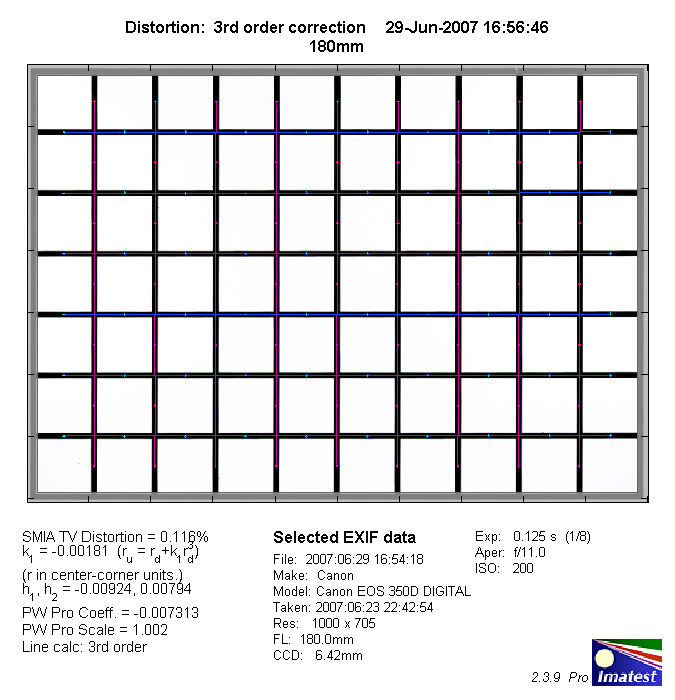|
Tamron AF 180mm f/3.5 SP Di LD [IF] macro (Canon) Review / Test Report - Analysis |
|
Lens Reviews -
Canon EOS (APS-C)
|
|
Page 2 of 2
Distortion
Typical for macro lenses the Tamron shows only a negligible degree of distortion.

The chart above has a real-world size of about 120x80cm.
Vignetting
The Tamron is a full-format lens so it can take advantage of the usual sweet spot effect
when used on an APS-C DSLR. Generally vignetting is no real problem even at f/3.5 and
at smaller aperture settings it is a non-issue.

MTF (resolution)
Typical for most macro lenses the resolution characteristic is very impressive.
At f/3.5 the quality figures are already on a very good level. Stopping down
results in a further increase in resolution till reaching an excellent maximum
around f/8. At f/16 the quality is a still on a very good level whereas f/22
suffers from a higher decrease due to diffraction effects (a physical
limitation). f/32 (not shown below) should be generally avoided.
Please note that the MTFs charts below represent the performance near infinity
focus. For the time being dedicated macro performance tests are not possible.
Please note that the MTF results are not directly comparable across the different systems!
Below is a simplified summary of the formal findings. The chart shows line widths per picture height (LW/PH) which can be taken as a measure for sharpness.
If you want to know more about the MTF50 figures you may check out the corresponding Imatest Explanations
Chromatic Aberrations (CAs)
Chromatic aberrations (color shadows at harsh contrast transitions) are very well
controlled from f/5.6 to f/22. The problem is somewhat more pronounced at f/3.5
with an average pixel width of 0.8px at the image borders which is usually not
a real issue.

Sample Images
You may check out the sample images of the Nikon variant of this lens.
Verdict
The Tamron AF 180mm f/3.5 SP Di LD [IF] macro offers a near-flawless performance.
Optically it doesn't leave anything to be desired - the resolution is very good to
excellent from f/3.5 all the way down to f/16 and vignetting, CAs and distortions
are usually non-issues in field conditions. The bokeh (out-of-focus blur), a primary aspect
in macro photography, is very smooth and buttery.
The build quality of the Tamron is very good but there is one bug - the lens has no
focus limiter and the rather slow AF combined with AF hunting can be a frequent and
rather tiresome experience. Thanks to a focus clutch mechanism you can switch between
AF and MF as easy as pushing/pulling the focus ring so if necessary you should give
the AF a better hint by manual pre-focusing. Other than that it is a really impressive
lens.
|